The Insulin Pumps Market is estimated to be valued at USD 8.1 billion in 2025 and is projected to reach USD 21.6 billion by 2035, registering a compound annual growth rate (CAGR) of 10.3% over the forecast period.
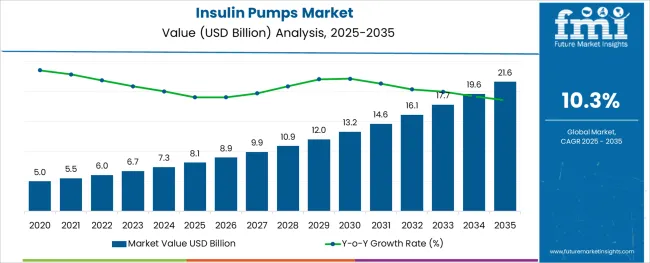
The alginic acid market is undergoing consistent growth, propelled by rising demand from food processing, pharmaceutical formulations, and cosmetic applications. A growing focus on natural and sustainable ingredients in manufacturing processes has positioned alginic acid as a preferred biopolymer across industries.
The market is further supported by its diverse functional benefits, including water retention, gelling, and stabilizing properties, which make it indispensable in high-performance formulations. Increased regulatory acceptance of alginates as safe additives and the push towards cleaner labeling in food and personal care products have reinforced their adoption.
Ongoing innovation in extraction technologies and the utilization of algae as a renewable resource are paving the way for cost-effective production and expanded applications, ensuring sustained market expansion in the coming years.
The market is segmented by Type, Product Type, Accessories, and End-User and region. By Type, the market is divided into Patch Pumps and Tethered Pumps. In terms of Product Type, the market is classified into Tandem, Accu-Chek, MiniMed, Omnipod, My Life Omnipod, and Other Product Types. Based on Accessories, the market is segmented into Insulin reservoir or cartridges, Insulin set insertion devices, and Battery. By End-User, the market is divided into Homecare, Hospitals & clinics, and Laboratories. Regionally, the market is classified into North America, Latin America, Western Europe, Eastern Europe, Balkan & Baltic Countries, Russia & Belarus, Central Asia, East Asia, South Asia & Pacific, and the Middle East & Africa.
The market is segmented by Type, Product Type, Accessories, and End-User and region. By Type, the market is divided into Patch Pumps and Tethered Pumps. In terms of Product Type, the market is classified into Tandem, Accu-Chek, MiniMed, Omnipod, My Life Omnipod, and Other Product Types. Based on Accessories, the market is segmented into Insulin reservoir or cartridges, Insulin set insertion devices, and Battery. By End-User, the market is divided into Homecare, Hospitals & clinics, and Laboratories. Regionally, the market is classified into North America, Latin America, Western Europe, Eastern Europe, Balkan & Baltic Countries, Russia & Belarus, Central Asia, East Asia, South Asia & Pacific, and the Middle East & Africa.
When segmented by salts, sodium alginate is expected to command 27.5% of the market revenue in 2025, marking it as the leading subsegment in this category. This leadership has been driven by its superior solubility, ease of incorporation into formulations, and versatility in a wide range of applications.
Its ability to form stable gels and maintain viscosity under varying conditions has made it highly sought after in both food and pharmaceutical sectors. Manufacturers have prioritized sodium alginate due to its consistent performance, cost-effectiveness, and regulatory acceptance, which have collectively strengthened its position.
The segment’s prominence has also been enhanced by its adaptability to evolving consumer preferences for plant-derived and sustainable ingredients, reinforcing its market share.
Segmented by end user industry, the food industry is projected to hold 33.0% of the market revenue in 2025, positioning it as the most prominent sector. This dominance has been shaped by the industry’s increasing reliance on alginic acid and its derivatives to deliver desirable textures, stabilize emulsions, and improve shelf life of processed foods.
As consumer demand for clean label and natural additives has intensified, the food sector has responded by integrating alginates into bakery, dairy, and confectionery products. Enhanced production efficiency and compliance with food safety standards have further encouraged widespread use.
The segment’s leadership has also been supported by product differentiation strategies where alginates contribute to premium quality and innovation, securing their role in modern food formulations.
When analyzed by functionality, thickening agents are forecast to account for 29.0% of the market revenue in 2025, establishing themselves as the dominant functional category. This preeminence has been underpinned by the growing need for consistent texture and viscosity in a wide array of end products.
Alginic acid’s natural origin and high efficiency in creating uniform, stable thickness without altering taste or color have solidified its appeal. The demand for thickeners in both edible and topical applications has expanded, with manufacturers leveraging its rheological properties to meet performance and regulatory requirements.
The functionality’s leading share has also been reinforced by the ability to deliver cost savings through lower dosages and its compatibility with other ingredients, securing its position as an indispensable component in formulation strategies.
As per the Insulin Pump market research by Future Market Insights - a market research and competitive intelligence provider, historically, from 2020 to 2024, the market value of the Insulin Pump markets increased at around 9.6% CAGR, wherein, the region North America held a significant share in the global market.
The dominance of chronic diseases like chronic respiratory diseases, mental illnesses, cancer, and diabetes surged the demand for Insulin pumps. Apart from this, by 2035, The WHO (World Health Organization) estimated that the global population aged 60 years and over will increase to 1.4 billion. The growing age of the elderly population is also a key factor in driving the market for Insulin pumps. Owing to this, the Insulin Pump market is projected to grow at a CAGR of 9.8% over the coming 10 years.
Technological developments and the increasing use of insulin pumps over older techniques which is affecting insulin market growth. Insulin pumps are useful for patients who need several insulin injections on a daily basis. Because these devices are less intrusive, they are widely used by patients. The growing elderly population, rising diabetes incidence, and obesity rates prevalence are factors driving market expansion.
Additionally, firms are creating next-generation insulin pumps with advanced technology to improve compliance and interaction with IT devices, which is adding to market growth. Technological advancements such as the artificial pancreas and home infusion treatment are also expected to generate major growth prospects in the near future.
One of the reasons driving market expansion is an increase in the incidence of diabetes owing to age, obesity, and an unhealthy lifestyle. Obesity is a primary cause of diabetes, which leads to a rise in the prevalence of diabetes-related ocular illnesses.
In 2020, the worldwide incidence of diabetes was estimated to be about 5 million, the prevalence was reported to be around 476 million, 1.37 million fatalities were recorded owing to diabetes, and 1.37 million disability-adjusted life-years (DALYs) were reported to be related to diabetes. According to the WHO, over 1.9 billion individuals were overweight in 2020, with around 650 million people classed as obese.
Obesity and being overweight are risk factors that are increasing the occurrence of type II diabetes. As a result, risk factors such as smoking, being overweight, being obese, and having high cholesterol are likely to increase the prevalence of type II diabetes.
With over 14.8% and 13.1% projected growth rates in China and Japan respectively, the Insulin Pump market revenue is expected to grow at the fastest pace in the Asia Pacific, from 2025 to 2035. Some of the key companies having manufacturing units in all major locations in APAC have started to expand their production units to different locations of APAC to increase the fast distribution of their products. While this implies to a shift in the diversification of global locations, it promises a significant opportunity for the Insulin Pump market.
Technology advancements, increased investment, improved reimbursement scenarios, and an increase in medical tourism are all aspects that are expected to drive market expansion. Furthermore, in the approaching years, the demand in the Asia Pacific is predicted to be boosted by a growing aging population combined with an increasing burden of chronic diseases.
According to a UNFPA report, the aging population in the APAC is increasing at an unprecedented rate, and by 2050, one in every four persons in the region would be over 60 years old, bringing the total population to close to 1.3 billion.
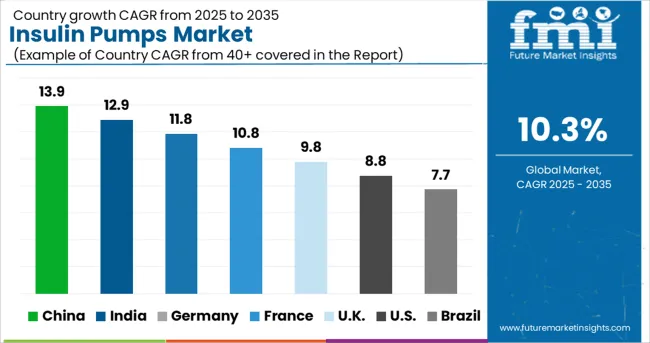
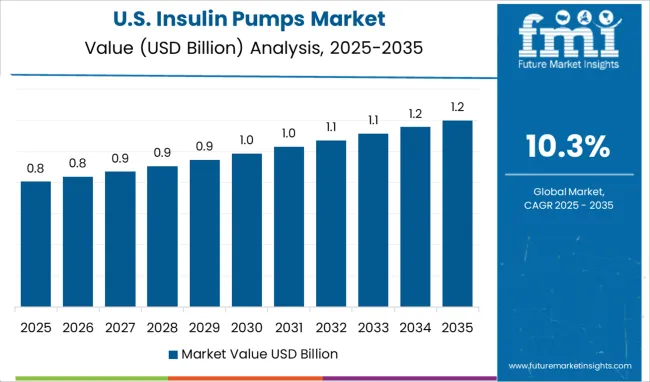
USA dominated the North America Insulin Pump market and is poised to reach USD 8.11.6 billion by 8.1038.1. The growing number of hospital admission and ease of Medicare reimbursement policy favors market growth. The market in The USA is projected to garner an absolute dollar opportunity of USD 8.1 billion from 8.108.18.1 to 8.1038.1.
The market in The United Kingdom is expected to grow from USD 8.169 million to reach a valuation of USD 775 million, growing at a CAGR of 11.1% from 8.108.18.1 to 8.1038.1. The market in the country is projected to garner an absolute dollar opportunity of USD 506 million from 8.108.18.1 to 8.1038.1.
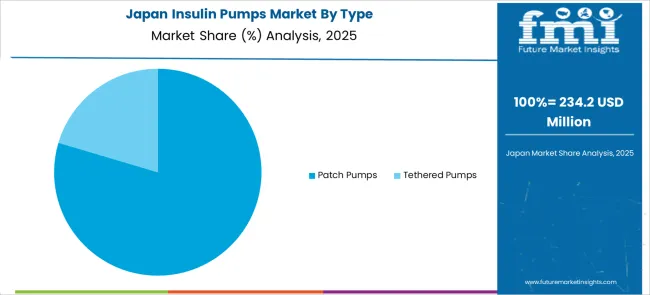
The market in Japan is likely to reach USD 781 million by 8.1038.1, growing at a CAGR of 13% from 8.108.18.1 to 8.1038.1. The market in the country is projected to garner an absolute dollar opportunity of USD 553 million.
In 2024, the tethered pumps category led the market, accounting for 78.5% of the total revenue. During the projection period, the category is predicted to grow at a CAGR of 13.4%. Flexible tubing connects the pump to the cannula in tethered pumps. The segment's enormous market size is mostly due to the dependability of these classic pumps and the variety of devices available on the market.
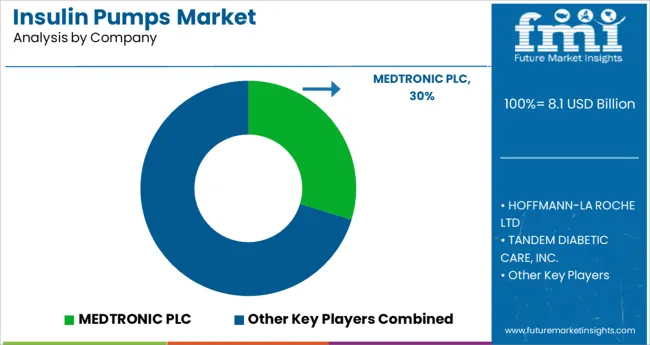
Over the projected period, rising emphasis on innovations and investments among public and private entities is expected to strengthen competition in the market. In addition, product commercialization and partnership tactics are expected to be profitable in the upcoming years.
The key vendors in the global Insulin Pump market are Cellenovo, Sooil Development, Valeritas, Inc, JingasuDelfu Co., Ltd., Medtronic plc, Hoffmann-La Roche Ltd, Tandem Diabetic Care, Inc., Insulet Corporation, and Ypsomed.
Some of the recent developments in the Insulin Pump market are:
The global insulin pumps market is estimated to be valued at USD 8.1 billion in 2025.
It is projected to reach USD 21.6 billion by 2035.
The market is expected to grow at a 10.3% CAGR between 2025 and 2035.
The key product types are patch pumps and tethered pumps.
tandem segment is expected to dominate with a 32.1% industry share in 2025.






Our Research Products

The "Full Research Suite" delivers actionable market intel, deep dives on markets or technologies, so clients act faster, cut risk, and unlock growth.

The Leaderboard benchmarks and ranks top vendors, classifying them as Established Leaders, Leading Challengers, or Disruptors & Challengers.

Locates where complements amplify value and substitutes erode it, forecasting net impact by horizon

We deliver granular, decision-grade intel: market sizing, 5-year forecasts, pricing, adoption, usage, revenue, and operational KPIs—plus competitor tracking, regulation, and value chains—across 60 countries broadly.

Spot the shifts before they hit your P&L. We track inflection points, adoption curves, pricing moves, and ecosystem plays to show where demand is heading, why it is changing, and what to do next across high-growth markets and disruptive tech

Real-time reads of user behavior. We track shifting priorities, perceptions of today’s and next-gen services, and provider experience, then pace how fast tech moves from trial to adoption, blending buyer, consumer, and channel inputs with social signals (#WhySwitch, #UX).

Partner with our analyst team to build a custom report designed around your business priorities. From analysing market trends to assessing competitors or crafting bespoke datasets, we tailor insights to your needs.
Supplier Intelligence
Discovery & Profiling
Capacity & Footprint
Performance & Risk
Compliance & Governance
Commercial Readiness
Who Supplies Whom
Scorecards & Shortlists
Playbooks & Docs
Category Intelligence
Definition & Scope
Demand & Use Cases
Cost Drivers
Market Structure
Supply Chain Map
Trade & Policy
Operating Norms
Deliverables
Buyer Intelligence
Account Basics
Spend & Scope
Procurement Model
Vendor Requirements
Terms & Policies
Entry Strategy
Pain Points & Triggers
Outputs
Pricing Analysis
Benchmarks
Trends
Should-Cost
Indexation
Landed Cost
Commercial Terms
Deliverables
Brand Analysis
Positioning & Value Prop
Share & Presence
Customer Evidence
Go-to-Market
Digital & Reputation
Compliance & Trust
KPIs & Gaps
Outputs
Full Research Suite comprises of:
Market outlook & trends analysis
Interviews & case studies
Strategic recommendations
Vendor profiles & capabilities analysis
5-year forecasts
8 regions and 60+ country-level data splits
Market segment data splits
12 months of continuous data updates
DELIVERED AS:
PDF EXCEL ONLINE
Insulin Biosimilar Market Size and Share Forecast Outlook 2025 to 2035
Insulin Pen Packaging Market Analysis - Size, Share, and Forecast Outlook 2025 to 2035
Insulin Pens Market – Growth & Forecast 2025 to 2035
Insulin Management System Market Growth - Trends & Forecast 2025 to 2035
Insulin Delivery Pen Market Growth – Trends & Forecast 2024-2034
Insulin Patch Pump Market
Non-Insulin Peptide Drugs Market Analysis - Size, Share, and Forecast Outlook 2025 to 2035
CIS Insulin Market Size and Share Forecast Outlook 2025 to 2035
Hyperinsulinemia Hypoglycaemia Treatment Market Insights by Type, Treatment, End User, and Region through 2035
Smart Insulin Pens Market Insights – Demand, Size & Industry Trends 2025 to 2035
The Disposable Insulin-delivery Device Market is segmented by Delivery Pumps, Patches, Pens, and Syringes from 2025 to 2035
Veterinary Insulin Drugs Market
Global Non-injectable Insulin Market Insights – Size, Trends & Forecast 2024-2034
Congenital Hyperinsulinism Treatment Market - Demand & Innovations 2025 to 2035
Pumps Market Size and Share Forecast Outlook 2025 to 2035
Pumps and Trigger Spray Market Trends - Growth & Forecast 2025 to 2035
Mud Pumps Market Growth - Trends & Forecast 2025 to 2035
Lobe Pumps Market
Solar Pumps Market Analysis - Size, Share, and Forecast Outlook 2025 to 2035
Charge Pumps Market Size and Share Forecast Outlook 2025 to 2035

Thank you!
You will receive an email from our Business Development Manager. Please be sure to check your SPAM/JUNK folder too.
Chat With
MaRIA